Beaucoup se sont installés dans des bâtiments qui avaient d’autres fonctions à l’origine : hôtels particuliers, centres de conférences, résidences… Ainsi, le Shangri-la, palace cinq étoiles était l’ancien hôtel particulier du neveu de Napoléon III, Roland Bonaparte. Le Mathurin, quant à lui, s’est installé dans deux anciens immeubles résidentiels.
On reproche pourtant souvent aux hôtels parisiens de proposer à leurs clients des chambres petites. Mais cela ne vient pas d’un désir de léser le client, il est rare que les établissements hôteliers furent conçus pour l’accueil de visiteurs, et par conséquent, rares, que les chambres des bâtiments reconvertis soient aussi larges qu’on pourrait le souhaiter. On ne choisit pas sa taille et son espace.
Les hôtels historiques à Paris se comptent sur le bout des doigts et sont souvent des palaces qui ont l’avantage d’avoir été conçus pour accueillir les visiteurs en voyages touristiques ou d’affaires. Ces bâtiments furent donc pensés et crées pour l’accueil des clients et pour leur offrir le séjour le plus agréable et le plus spacieux possible. Passage en revue non exhaustif.
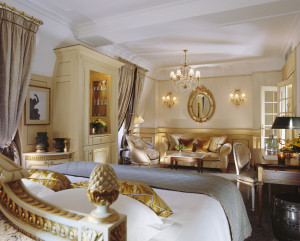
Le Meurice (voir notre article)
Le Meurice fut crée en 1771 par Augustin Meurice. Il s’agissait à l’origine d’une auberge à Calais pour accueillir des touristes anglais. Le but était de leur permettre de trouver sur l’hexagone le luxe auquel ils pouvaient être habitués chez eux.
Sous la restauration, un hôtel fut ouvert à Paris au 223 rue saint Honoré. Le style de cette hôtellerie était inédit pour l’époque. En effet, tout était fait pour faciliter la vie au voyageur de passage. L’hôtel fut déménagé rue de Rivoli en 1835 et occupe encore cet emplacement aujourd’hui. Parmi ses plus fameux locataires on trouve notamment miss Howard, maîtresse de Napoléon III.
Au début du XXe siècle, Le Meurice changea de direction. L’un des principaux actionnaires en était Arthur Million, propriétaire du café de la Paix. Afin de concurrencer le Ritz, ouvert en 1898, Millon fit appel à un grand hôtelier suisse, Frédéric Schwenter. Sous l’impulsion des deux hommes, Le Meurice fut agrandi par l’adjonction de l’hôtel Métropole. L’hôtel fut reconstruit à neuf à l’exception des façades classée. Les chambres furent dotées du confort le plus moderne (salles de bains, téléphone…). Un ascenseur fut également ajouté qui était la copie de la chaise à porteurs de Marie-Antoinette d’Autriche.
L’hôtel a bénéficié au cours des années 2000 d’une vaste campagne de rénovation et se targue sur son site de ses chambres et suites « oasis de calme et d’espace, révélation du plus grand des luxes».
Le Ritz
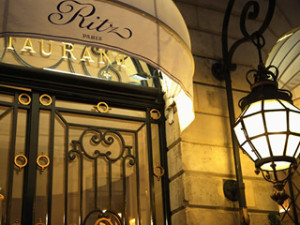
Rival historique du Meurice, le Ritz fut fondé en 1898 par l’hôtelier suisse César Ritz et le chef Auguste Escoffier. Il était auparavant l’hôtel particulier de Gramont mais l’architecte Charles Mewès le transforma en hôtel en 1897. Il fut classé monument historique en 1930. Le Ritz a accueilli tout au cours du 20 ème siècle les personnalités les plus prestigieuses dont Hemingway, Chaplin, Coco Chanel qui y vécu 30 ans, le shah d’Iran…
Cédé en 1979 à l’homme d’affaires égyptien Mohamed Al-Fayed, l’hôtel connu une grande vague de restauration dans les années 80.
Actuellement fermé pour travaux, le Ritz propose 159 chambres dont 56 suites et 6 suites de prestige avec vue sur la place Vendôme, telle la suite Coco Chanel avec sa vue sur la place Vendôme et ses six mètres de plafond !
Le Plaza Athénée (notre article)
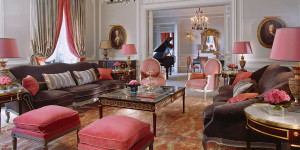
Rouvert au public le premier août dernier, le Plaza fut construit entre 1902 et 1909 par les architectes Lefebvre et Duhayon. Modernisé en 1933 avec le changement de propriétaire, il rouvre en 1936. Après avoir servi pendant la seconde Guerre de logement aux commandements américains et allemands, il reprend son activité commerciale en 1946. Connu pour avoir été le lieu d’arrestation de Mata Hari ou encore le lieu de refuge de Jean Gabin et Marlène Dietrich, l’hôtel n’a eu de cesse de se renouveler depuis son ouverture. Pour preuve, il dépense depuis 1997 1.5 million d’€ chaque année pour ses travaux.
L’hôtel compte 148 chambres et 46 suites dont l’une de plus fameuses est la suite Royale qui mesure 450m2 !
Le Four Seasons Hôtel George V
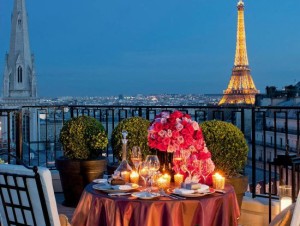
Situé sur la « plus belle avenue du monde », le George V fut construit en 1928. Il fait aujourd’hui partie de la chaîne Four Seasons et du club fermé des palaces parisiens. Il offre 244 chambres, pour 59 suites, dont certaines avec une vue grandiose sur la basilique du Sacré-Cœur de Montmartre ou la tour Eiffel. L’une des plus connues est le Penthouse, véritable appartement au sommet de l’hôtel avec sa terrasse qui donne vue sur le tout Paris.
La deuxième partie de l’article à lire ici
The original hotels
Many hotels are established in buildings originally conceived for different purposes: private mansions, conference centres, apartment blocks, etc. One such example is the Shangri-La, the five-star palace that used to be the private mansion of Roland Bonaparte, Napoleon III’s nephew.
Yet Parisian hotels are often rebuked for the small rooms they offer their guests. This is not a matter of wanting to displease the client, however; it is simply rare for these hotels to have been designed to accommodate visitors, meaning that the rooms in the reconverted buildings are rarely as large as guests might hope. We can’t choose their size and space.
Paris’ historical hotels are a dying breed, and many of them are palaces with the advantage of having been created for the purpose of accommodating holiday-makers and business travellers. They have therefore been designed and built in such a way as to make guests feel welcome and offer them the most pleasant and spacious stay possible. Here is a non-exhaustive run-down.
The Meurice (see our article)
The Meurice was created by Augustin Meurice in 1771. Originally, it was an inn for English tourists in Calais. Its goal was to provide them a place in mainland France that was every bit as luxurious as what they were used to back home.
During the Restoration, a hotel opened at 223 Rue Saint Honoré, Paris that introduced a brand new style of hotel management: everything was designed to make life easier for the travelling guest. The hotel moved to Rue de Rivoli in 1835 and has remained there to this day. One of its most famous residents was Miss Howard, Napoleon III’s mistress.
At the start of the 20th century, the Meurice’s management changed. Arthur Million, the owner of Café de la Paix and one of the hotel’s major shareholders, called upon Frédéric Schwenter, a great Swiss hotel manager, to help him develop an establishment capable of competing with the Ritz, which had opened in 1898. At the instigation of these two men, the Meurice was enlarged by adding the Hôtel Métropole. The hotel was completely rebuilt, apart from the listed façades. The rooms were fitted with modern equipment for maximum comfort (bathrooms, telephone, etc.). A lift inspired by Marie Antoinette of Austria’s sedan chair was also added.
In the 2000s, the hotel underwent an extensive renovation project and now boasts on its website that each room and suite is “a spacious, peaceful oasis of calm, providing guests with the ultimate in luxury”.
The Ritz
The Ritz, arch-rival of the Meurice, was founded in 1898 by Swiss hotelier César Ritz and chef Auguste Escoffier. It had previously been a private mansion belonging to the Gramont family, but architect Charles Mewès converted it into a hotel in 1897. It was listed as a historical monument in 1930. Over the 20th century, the Ritz has welcomed a host of prestigious guests, including Hemingway, Chaplin, Coco Chanel (who lived there for 30 years) and the Shah of Iran.
Sold in 1979 to Egyptian businessman Mohamed Al-Fayed, the hotel underwent a wave of major restoration work in the 80s. Currently closed for work, the Ritz boasts 159 rooms including 56 suites and 6 prestige suites overlooking Place Vendôme – such as the Coco Chanel suite, with its view of Place Vendôme and its six-metre high ceilings!
The Plaza Athénée (our article)
Currently closed for renovation and scheduled to reopen on 1 August, the Plaza was built between 1902 and 1909 by the architects Lefebvre and Duhayon. Modernised in 1933 after its ownership changed hands, it reopened in 1936. After being used to house American and German commanders during the Second World War, it resumed business in 1946. Renowned for being the place where Mata Hari was arrested, and as Jean Gabin and Marlène Dietrich’s love nest, the hotel has continually reinvented itself since it first opened – as proved by its expenditure of €1.5 million each year since 1997 on renovations.The hotel has 148 rooms and 46 suites, one of the most famous of which is the Suite Royale which measures 450m2!
The Four Seasons George V
Located on “the most beautiful avenue in the world”, the George V was built in 1928. Today, it belongs to the Four Seasons chain and the private circle of Parisian palaces. It offers 244 rooms and 59 suites, some of which boast sumptuous views of the Sacré-Cœur Basilica in Montmartre or the Eiffel Tower. One of the best-known suites is the Penthouse, an entire apartment at the top of the hotel with a balcony overlooking all Paris.
Didier MOINEL DELALANDE


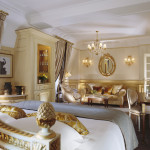




Un commentaire pour “Les hôtels d’origine (1/2)”